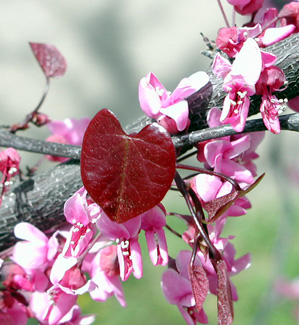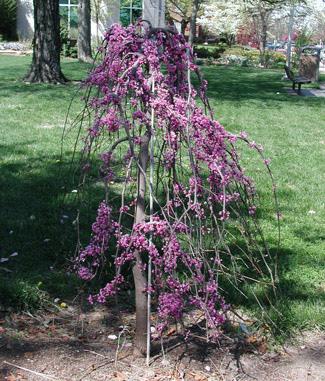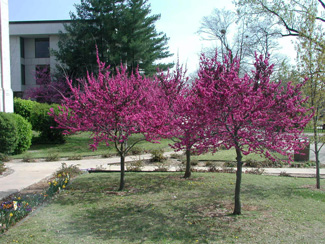Resource Library
Plant of the Week: Redbud Cultivars

Forest Pansy redbud with its maroon summertime foliage was one of the first of the new wave of redbud cultivars to gain widespread recognition. (Image courtesy Gerald Klingaman)
Download High Resolution
Plant of the Week
Redbud Cultivars
Latin: Cercis canadensis
Redbuds are a common sight in the Arkansas landscape in the springtime both in gardens and in the wild. Though mostly seen in varying shades of purple or lavender, there is variation amongst their ranks and nurserymen have been busy over the last couple decades selecting cultivars that have unique characteristics for use in the garden.
There are nine species of redbuds known in the world with two native to North America. The Eastern Redbud (Cercis canadensis) is most frequently listed as having three botanical varieties; var. canadensis (the typical form), mexicana (a smaller shrubby form with a rounded leaf) and texensis (a compact tree form with glossy leaves). Some botanists elevate these varieties to species rank.
The typical redbud is a small, 20-foot tall deciduous tree with low branching and a broad, oval crown. Leaves are heart-shaped and usually 4 to 5 inches long and wide. In variety texensis the leaves are about half the size as the typical form with the upper leaf surface a deep, glossy green.
The leguminous flowers are a third of an inch tall and produced in clusters directly from the branches and sometimes trunks. Flower colors range from lighter to darker shades of purple or lavender but white and clear pink forms are available. Most years the flowers are followed by a heavy crop of 4-inch-long flattened pea pods that turn gray-black in the fall and persist on the trees throughout the winter.

Covey was the first weeping redbud form to hit the market. (Image courtesy Gerald Klingaman)
Download High Resolution
Until recently redbuds were nearly always grown from seed so clonal reproduction was rare. However, with the widespread acceptance of the purple-leafed ‘Forest Pansy’ and the glossy leafed ‘Oklahoma,’ nurserymen began budding, and sometimes successfully rooting, plants to make the clones available to a wider market. Now there are at least three-dozen clones in the nursery trade.
Flower colors range from deep magenta-purple as seen in ‘Oklahoma’ to true pink forms such as ‘Appalachian Red’ or ‘Rubye Atkinson’ to white forms such as ‘Alba’ or ‘Royal White’. Foliage color and plant form have been the main feature nurserymen have been focusing on of late.
In addition to purple-leafed forms such as ‘Forest Pansy’ and Burgundy Hearts®, now there are a number of white-variegated forms such as ‘Floating Clouds’ and ‘Silver Cloud.’ Since 2010, about five new golden-foliage type redbuds have hit the market including ‘Merlot,’ ‘Hearts of Gold,’ and the orange-tinted Rising Sun®. How purple or golden the foliage remains during the heat of the summer varies with conditions, but during May and June all of these plants put on an impressive foliage display.
Weeping forms are another opportunity for using redbuds as small specimen plants. ‘Covey’ (or Lavender Twist®) is a green-leafed weeper growing to about 6 feet tall with dramatically weeping branches. ‘Ruby Falls’ is a purple-leafed weeper of similar size. Because of the tight weeping form of these plants it takes a raised planter or an elevated knoll and some judicious pruning to show them off to best advantage.
Redbuds are easy to grow from zone 5 through zone 8 and are well suited to all parts of Arkansas. They are best in full sun but the forms with colored foliage may benefit from late afternoon shade to lessen the fading problems associated with summertime heat. Plants need good drainage but are tolerant of a wide array of soil conditions and, once well established, have considerable drought tolerance.

Oklahoma is perhaps the best of the glossy leafed Texas redbud selections. (Image courtesy Gerald Klingaman)
Download High Resolution
By: Gerald Klingaman, retired
Extension Horticulturist - Ornamentals
Extension News - April 25, 2014